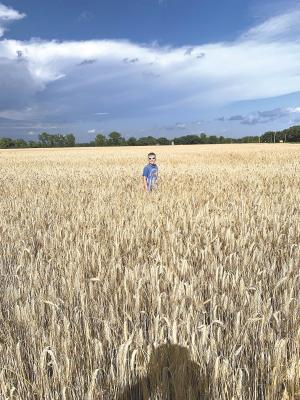2019 - Volume #43, Issue #5, Page #06
[ Sample Stories From This Issue | List of All Stories In This Issue | Print this story
| Read this issue]
Hybrid Rye Earns A Premium
 |
“Our irrigated winter rye averaged 85 bushels per acre, and we are still learning,” says Peterson. “With 4-ft. tall plants, there is a lot of straw to push through the combine. We had to adjust settings and cut only 20-ft. swaths with our 30-ft. header. We are happy with the 85 bushel average, but we definitely have the potential to do better.”
The Petersons have planted rye on dry land in the past with yields of 30 bushels or less. They hesitated to put it on irrigated acres or push much nitrogen to it, due to its tendency to get too tall and lodge. But with the Bono Hybrid Winter Rye variety, that wasn’t a problem.
“We gave it about 80 to 85 lbs. of nitrogen per acre,” says Peterson. “Some was side dressed and some delivered through the pivot closer to the end, before it matured. It had great standability and didn’t lodge.”
Before they even sold the rye, they harvested a side benefit of 5 big round bales of straw per acre.
Marketing began with a malting company contract for 50 bushels per acre. The remainder of the yield this year will go to other food or distillery users.
The family farming enterprise is a diverse operation, feeding out Holstein steers and raising corn and soybeans, as well as seed corn and kidney beans. In fact, the rye was an experiment resulting from cover crops failing behind kidney beans.
Although drilled in September, the cold fall slowed growth. However, it came back strong in the spring. Peterson is satisfied enough that he plans to double his acreage from 100 to 200 this fall. University of Minnesota yield trials have shown average yields across multiple sites of as high as 125 bushels per acre and 3-year averages of 104 bushels per acre.
According to Albert Lea Seed House, Peterson’s supplier, the hybrid rye produces 8 to 20 tillers per plant in the fall, with each tiller potentially producing a head (www.alseed.com; ph 800-352-5247).
Fall-tillered rye sets heads and pollinates earlier than spring rye, reducing potential ergot infestation. In fact, the hybrid rye sheds pollen so quickly that the company says a dust cloud of pollen can be seen. This is important, as once pollinated, the rye flower closes and is no longer susceptible to ergot spores.
Although Peterson grew his under irrigation, the hybrid rye is also promoted as high yielding under dryland conditions. The only real downside is that seed can’t be saved for replanting. However, that trade-off is worth it for Peterson.
“We are always looking for more rotation crops, especially non soybean cyst nematode host crops,” says Peterson.
Contact: FARM SHOW Followup, A&L Peterson Farms, 9200 57th St., Clear Lake, Minn. 55319 (ph 320-743-2551)

Click here to download page story appeared in.

Click here to read entire issue
To read the rest of this story, download this issue below or click here to register with your account number.




